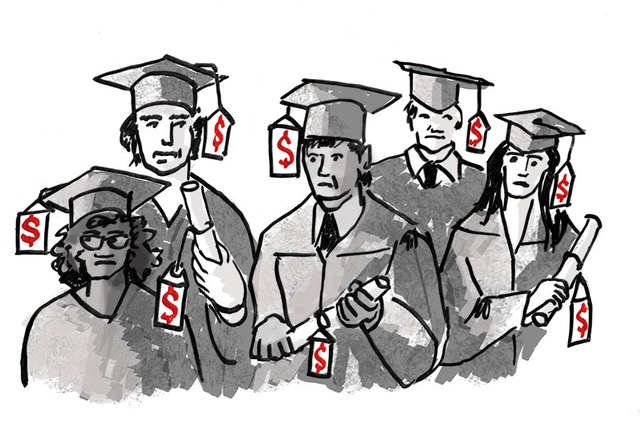A look at why it is so expensive to attend university.
It is a simple fact that for young people entering the workforce a college degree is necessary to make a decent living. Graduates with a higher education degree earn double what high school graduates make.
But the sad fact is that a university degree is becoming increasingly unaffordable. Tuition prices at public universities in Oregon have steadily increased over the past 10 years, and show no signs yet of abating.
Average annual tuition and fees were $8,764 (2015-16 academic year) for a resident, full-time student at public university in Oregon, a 38% increase since 2005-06 (adjusted for inflation). For non-resident full-time students, tuition and fees have increased 36% over the same period to $24,927. Figures come from the HECC Office of Research and Data, a state agency that analyzes data on postsecondary education.
Here is a look at the main drivers for the tuition increase:
Labor costs
Higher education is still, for the most part, labor intensive. Unlike other areas of the economy that have been automated and have lower labor costs, a university education still relies mostly on human capital.
“Any kind of service or product that is highly labor intensive and for which there are no good technological substitutes will have inflation that is faster than you observe in the market as a whole,” said John Tapogna, president of ECONorthwest, a consulting firm.
Then there are the additional escalating costs of pension and health insurance benefits. Portland State University spent $78 million on employee benefits in 2017, a 72% increase from 2007. Of Portland State’s $314 million education and general funds expenditures in 2017, one-quarter went to employee benefits.
At Oregon State University, a new pension liability reporting requirement resulted in a net increase of $146 million in compensation and benefits expense in 2016 over the previous year.
Even the emergence of online degrees, which theoretically should bring instruction costs down, have so far failed to curb tuition increases. David Feldman, a professor of economics at William & Mary University and author of ‘Why Does College Cost So Much?’, said that fully online tuition programs have actually required a large number of staff to keep going.
Extra costs
Universities are spending more money on student services and auxiliary programs that are unrelated to instruction. Some argue higher education institutions spend more than they need on these non-academic items, pushing up the overall costs for the student.
Student services include cultural events, career guidance and counseling. Auxiliary programs include residence halls, food services and student health services. Oregon State University spent $194 million on student services and auxiliary programs in 2016, a 13% increase on the previous year. It should be noted that the percentage spent on these services as part of their overall expenditures has not changed much over the past decade.
State disinvestment in higher education
The steady decline in state support for public universities is commonly cited as a reason for higher tuition costs. Although it is the not the main driver of escalating tuition, its impact is significant. The decline in state support in Oregon started in 2008 at the beginning of the last recession. In that year, the state appropriated $6,496 per full time student to public universities. By 2012, the state support had fallen 35% to $4,214.
Since 2012, it has started to climb back up, though it is still well below what it was 10 years ago. State support accounts for 27% of Portland State University’s education and general funds revenue in 2017, compared with 34% in 2007. It accounted for 7.2% of University of Oregon’s revenue in 2016, compared with nearly 11% 10 years ago.
As tuition continues to rise, the prospect that a higher education will be only for the wealthy is increasingly in the cards.
But economists point to a number of initiatives and macro-economic trends that may soon start to curb the price of attending university.
In Oregon, full-time enrollment at public universities started to soar in 2008 and peaked in 2012 when it hit almost 170,000 students. At the same time state support fell to a new low. Feldman attributes the soaring tuition costs in the past five years to universities catching up with a bloat in enrollment combined with the precipitous drop in state support. Now that full-time enrollment has started to decline since its peak – it is down 11% since 2012 – and state support has started to creep back up, “the era of soaring tuition costs is over,” predicted Feldman.
“I would be shocked if tuition does not moderate,” he said.
RELATED STORY: WORLDLY PURSUITS
Another reason tuition prices may stabilize is the fact students have more information on the rate of return of investing in a university degree.
For one, high school graduates now have more information on the expected earnings of majors and occupations than ever before. This may increasingly drive young people to shop for degrees that give the most added value.
A growing emphasis on making degree programs more specialized and shorter in duration to cut costs may also help to curb tuition eventually. “I think we will see more repackaging and laser-focused design of degrees,” said Tapogna.
Higher education institutions are also implementing more so-called “intrusive advising,” which pushes students to make decisions that ensure they complete their degrees in a shorter timeframe.
Higher education is still extraordinarily expensive for many families, whose wages have not kept up with the escalating tuition prices. The soaring costs are simply unsustainable. Universities will have no choice but to redesign to stay relevant to students and the businesses they serve.



